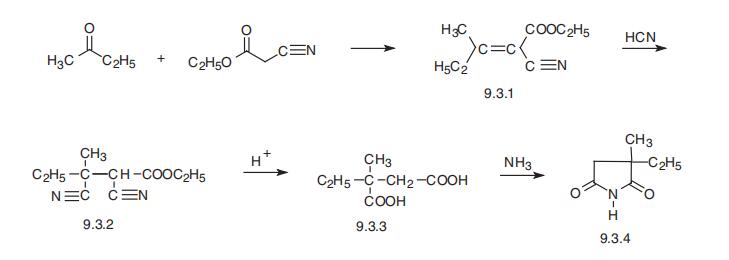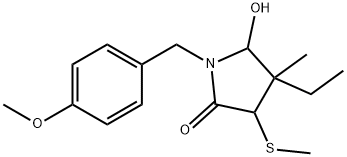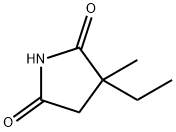ETHOSUXIMIDE
- CAS No.
- 77-67-8
- Chemical Name:
- ETHOSUXIMIDE
- Synonyms
- Zarontin;h940;Suxin;ci366;H 940;H-490;Pemal;pm671;Asamid;CI-366
- CBNumber:
- CB1420630
- Molecular Formula:
- C7H11NO2
- Molecular Weight:
- 141.17
- MDL Number:
- MFCD00072123
- MOL File:
- 77-67-8.mol
| Melting point | 51 °C |
|---|---|
| Boiling point | 150 °C / 12mmHg |
| Density | 1.1522 (rough estimate) |
| refractive index | 1.5026 (estimate) |
| storage temp. | 2-8°C |
| solubility | ethanol: 100 mg/mL |
| pka | pKa 9.5 (Uncertain) |
| color | White to Off-White |
| Water Solubility | 190g/L(25 ºC) |
| Merck | 14,3748 |
| BCS Class | 1,3 |
| CAS DataBase Reference | 77-67-8 |
| EWG's Food Scores | 1 |
| FDA UNII | 5SEH9X1D1D |
| NCI Drug Dictionary | ethosuximide |
| ATC code | N03AD01,N03AD51 |
SAFETY
Risk and Safety Statements
| Symbol(GHS) |  GHS07 |
|||||||||
|---|---|---|---|---|---|---|---|---|---|---|
| Signal word | Warning | |||||||||
| Hazard statements | H302 | |||||||||
| Precautionary statements | P264-P270-P301+P312-P501 | |||||||||
| Hazard Codes | Xn,T,F | |||||||||
| Risk Statements | 22-39/23/24/25-23/24/25-11 | |||||||||
| Safety Statements | 36-45-36/37-16-7 | |||||||||
| WGK Germany | 3 | |||||||||
| RTECS | WN2800000 | |||||||||
| HS Code | 2925190100 | |||||||||
| Toxicity | LD50 in mice (g/kg): 1.65 i.p.; 1.75 orally (Najer) | |||||||||
| NFPA 704 |
|
ETHOSUXIMIDE price More Price(31)
| Manufacturer | Product number | Product description | CAS number | Packaging | Price | Updated | Buy |
|---|---|---|---|---|---|---|---|
| Sigma-Aldrich | 1264002 | Ethosuximide United States Pharmacopeia (USP) Reference Standard | 77-67-8 | 500mg | $174.4 | 2024-03-01 | Buy |
| Sigma-Aldrich | BP146 | Ethosuximide British Pharmacopoeia (BP) Reference Standard | 77-67-8 | 200MG | $262 | 2023-06-20 | Buy |
| Sigma-Aldrich | 68459 | Ethosuximide analytical standard | 77-67-8 | 100mg | $73.5 | 2022-05-15 | Buy |
| TCI Chemical | E0746 | Ethosuximide >98.0%(GC)(T) | 77-67-8 | 5g | $45 | 2024-03-01 | Buy |
| TCI Chemical | E0746 | Ethosuximide >98.0%(GC)(T) | 77-67-8 | 25g | $129 | 2024-03-01 | Buy |
ETHOSUXIMIDE Chemical Properties,Uses,Production
Description
Ethosuximide is a first- generation antiepileptic drug (AED) known under the proprietary brand name of Zarontin® (Pfizer, New York, NY) in the UK and USA.
Generic formulation
MHRA/ CHM advice to minimize risk when switching patients with epilepsy between different manufacturers’ products (including generic products):
- It is usually unnecessary to ensure that patients are maintained on a specific manufacturer’s product unless there are specific concerns, such as patient anxiety and risk of confusion/ dosing error.
Indications
Epilepsy: monotherapy and adjunctive therapy of absence seizures; adjunctive therapy of generalized tonic- clonic seizures.
Recommendations summarized from NICE (2012)
- Seizure types: first line (absence seizures), adjunctive (absence seizures).
- Epilepsy types: first line (absence syndromes), adjunctive (absence syndromes).
Dose titration
250 mg bd, then increased in steps of 250 mg every 5– 7 days; usual maintenance 1000– 1500 mg daily, divided into two doses (max. 2000 mg daily).
Plasma levels monitoring
Monitoring ethosuximide plasma levels can be useful in selected cases, although the evidence for a therapeutic plasma range is limited (suggested therapeutic plasma concentrations 40–100 mg/ L) and a toxic limit has not been consistently defined.
Cautions
Patients with acute porphyrias.
Interactions
With AEDs
- Plasma concentration of ethosuximide is reduced by the glucuronidation inducers carbamazepine, phenytoin, phenobarbital, and primidone.
- Plasma concentration of ethosuximide has been reported to be both increased and decreased by valproate.
- Ethosuximide can raise serum levels of phenytoin.
With other drugs
Metabolism of ethosuximide is inhibited by isoniazid, resulting in increased plasma concentration and risk of toxicity.
With alcohol/food
There are no known specific interactions between alcohol and ethosuximide, and there are no specific foods that must be excluded from diet when taking ethosuximide.
Special populations
Hepatic impairment
Use with caution.
Renal impairment
Use with caution.
Pregnancy
- The dose of ethosuximide should be monitored carefully during pregnancy and after delivery, and adjustments made on a clinical basis.
- Ethosuximide crosses the placenta and cases of birth defects have been reported. Therefore, the prescribing physician should weigh the benefits versus the risks of ethosuximide in treating or counselling epileptic women of childbearing age.
- Ethosuximide is excreted in breastmilk and the effects of ethosuximide on the nursing infant are unknown. Therefore, ethosuximide should be used in nursing mothers only if the benefits clearly outweigh the risks and breastfeeding is best avoided.
Behavioural and cognitive effects in patients with epilepsy
Adverse behavioural effects can be of clinical significance, and include the possible induction of anxiety, depression, confusion, irritability, aggression, hallucinations, and intermittent impairment of consciousness These episodes can occur following cessation of seizures and normalization of the electroencephalogram (EEG), and resolve with discontinuation of ethosuximide and seizure recurrence (alternative psychosis in the context of forced normalization). Among first- generation AEDs, ethosuximide is characterized by a relatively favourable cognitive profile, with low incidence of cognitive adverse effects.
Psychiatric use
Ethosuximide as adjunctive treatment of bipolar disorder was found to be ineffective in patients with acute mania. This AED has no approved indications or clinical uses in psychiatry.
Chemical Properties
White to Off-White Solid
Originator
Zarontin,Parke Davis,US,1960
Uses
cholinergic
Uses
Anticonvulsant.
Uses
Ethosuximide is an anticonvulsant drug that is used in minor forms of epilepsy.
Definition
ChEBI: A dicarboximide that is pyrrolidine-2,5-dione in which the hydrogens at position 3 are substituted by one methyl and one ethyl group. An antiepileptic, it is used in the treatment of absence seizures and may be used for myoclonic seizures, but is ineffect ve against tonic-clonic seizures.
Manufacturing Process
α-Ethyl-α-methylsuccinimide is known in the prior art as a chemical entity,
having been prepared according to the method described by Sircar, J. Chem.
Soc., 128:600 (1927), and characterized in J. Chem. Soc., 128:1254 (1927).
In its manufacture, methyl ethyl ketone is condensed with ethylcyanoacetate
to give ethyl-2-cyano-3-methyl-2-pentenoate. That, in turn, adds HCN to give
ethyl-2,3-dicyano-3-methyl pentanoate. Saponification and decarboxylation
gives 2-methyl-2-ethyl succinonitrile. Heating with aqueous NH3 gives the
diamide which loses NH3 and cyclizes to ethosuximide.
brand name
Epileo Petitmal (Eisai), Pemal (Benzon), Petnidan (Desitin Arzneimittel), Suxilep (Parke – Davis, Jenapharm), Suxinutin/Zarontin (Parke – Davis).
Therapeutic Function
Anticonvulsant
Biological Functions
It is now generally accepted that the specific antiepileptic
action of ethosuximide (and the older agent trimethadione,
no longer employed) against absence
epilepsy is its ability to reduce the low-threshold calcium
current (LTCC) or T (transient) current. These
currents underlie the 3-Hz spike wave discharges that
are characteristic of absence epilepsy. A blockade of T-calcium current is likely also to be a mechanism used
by valproic acid.
The only clinical use for ethosuximide (Zarontin) is
in the treatment of absence epilepsy. If absence attacks
are the only seizure disorder present, ethosuximide
alone is effective. If other types of epilepsy are present,
ethosuximide can be readily combined with other
agents.
For the most part, ethosuximide is a safe drug. Most
of the side effects are dose related and consist of nausea,
gastrointestinal irritation, drowsiness, and anorexia.
A variety of blood dyscrasias have been reported, but
serious blood disorders are quite rare.
General Description
Ethosuximide is considered the prototypical anticonvulsantneeded for treating patients with absence seizures.Ethosuximide and the N-dealkylated active metabolite ofmethsuximide work by blocking the lowthresholdT-type calcium channels, thereby reducing thehyperexcitability of thalamic neurons that is specifically associatedwith absence seizure.
Biochem/physiol Actions
Ethosuximide is an anticonvulsant drug and an antagonist for T-type calcium channel. It is known to prevent spike wave discharges, characterized in absence seizures.
Clinical Use
Although ethosuximide is the drug of choice for treatment of simple absence seizures, it is not effective against partial complex
or tonic-clonic seizures and may increase the frequency of grand mal attacks. Thus, it must be administered in combination with
other AEDs when treating persons with mixed seizure types. Ethosuximide is a substrate for both CYP3A4 and CYP2E1. The
major metabolite for ethosuximide is 3-(1-hydroxyethyl) succinimide, which is inactive and excreted unconjugated into the urine Several additional metabolites have been characterized recently. Approximately 20% of an oral dose is excreted
unchanged.
Although ethosuximide is thought to be the least toxic of the succinimides, it can cause gastrointestinal disturbances and
dose-related CNS effects, such as drowsiness, dizziness, ataxia, sleep disturbances and depression. Idiosyncratic
hypersensitivity reactions include severe rashes, leukopenia, agranulocytosis (some fatal), systemic lupus erythematosus, and
parkinsonian-like symptoms. In addition to being less toxic than trimethadione, ethosuximide offers a wider range of protection
against different kinds of absence seizures.
Synthesis
Ethosuximide, 3-ethyl-3-methypyrrolidine-2,5-dione (9.3.4) is synthesized from methylethylketone and cyanoacetic ester, which are condensed in Knoevanagel reaction conditions. Then hydrogen cyanide is added to the resulting product (9.3.1). After acidic hydrolysis and decarboxylation of synthesized dinitrile (9.3.2), 2-methyl-2-ethylsuccinic acid (9.3.3) is formed. Reacting this product with ammonia gives the diammonium salt, and heterocyclization into the ethosuximide (9.3.4) takes place during subsequent heating [8,9].

Drug interactions
Potentially hazardous interactions with other drugs Antibacterials: concentration increased by isoniazid. Antidepressants: lower convulsive threshold; avoid with St John’s wort. Antiepileptics: concentration possibly reduced by carbamazepine, fosphenytoin, phenytoin and phenobarbital; concentration of fosphenytoin and phenytoin possibly increased; concentration increased by valproate. Antimalarials: anticonvulsant effect antagonised by mefloquine. Antipsychotics: lower convulsive threshold. Orlistat: possible increased risk of convulsions.
Metabolism
Ethosuximide is extensively hydroxylated in the liver to its principal metabolite which is reported to be inactive. Ethosuximide is excreted in the urine mainly in the form of its metabolites, either free or conjugated, but about 12-20% is also excreted unchanged.


ETHOSUXIMIDE Preparation Products And Raw materials
Raw materials
1of2
Preparation Products
| Supplier | Tel | Country | ProdList | Advantage | |
|---|---|---|---|---|---|
| Henan Tianfu Chemical Co.,Ltd. | +86-0371-55170693 +86-19937530512 | info@tianfuchem.com | China | 21695 | 55 |
| Hubei Jusheng Technology Co.,Ltd. | 18871490254 | linda@hubeijusheng.com | CHINA | 28180 | 58 |
| career henan chemical co | +86-0371-86658258 15093356674; | factory@coreychem.com | China | 29826 | 58 |
| Antai Fine Chemical Technology Co.,Limited | 18503026267 | info@antaichem.com | CHINA | 9641 | 58 |
| TargetMol Chemicals Inc. | +1-781-999-5354 +1-00000000000 | marketing@targetmol.com | United States | 19892 | 58 |
| Dideu Industries Group Limited | +86-29-89586680 +86-15129568250 | 1026@dideu.com | China | 29474 | 58 |
| AFINE CHEMICALS LIMITED | 0571-85134551 | info@afinechem.com | CHINA | 15377 | 58 |
| Alfa Chemistry | info@alfa-chemistry.com | United States | 2344 | 58 | |
| Dayang Chem (Hangzhou) Co.,Ltd. | 571-88938639 +8617705817739 | info@dycnchem.com | CHINA | 52867 | 58 |
| Shaanxi Didu New Materials Co. Ltd | +86-89586680 +86-13289823923 | 1026@dideu.com | China | 9309 | 58 |
View Lastest Price from ETHOSUXIMIDE manufacturers
| Image | Update time | Product | Price | Min. Order | Purity | Supply Ability | Manufacturer | |
|---|---|---|---|---|---|---|---|---|
 |
2021-07-23 | ETHOSUXIMIDE USP/EP/BP
77-67-8
|
US $1.10 / g | 1g | 99.9% | 100 Tons min | Dideu Industries Group Limited | |
 |
2020-01-10 | Ethosuximide
77-67-8
|
US $1.00 / KG | 1KG | ≥98% | 20 tons | Career Henan Chemical Co |
-

- ETHOSUXIMIDE USP/EP/BP
77-67-8
- US $1.10 / g
- 99.9%
- Dideu Industries Group Limited
-

- Ethosuximide
77-67-8
- US $1.00 / KG
- ≥98%
- Career Henan Chemical Co
77-67-8(ETHOSUXIMIDE)Related Search:
1of4





